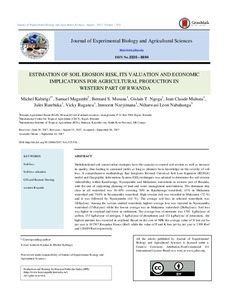| dc.contributor.author | Kabirigi, M. |
| dc.contributor.author | Mugambi, S. |
| dc.contributor.author | Musana, B.S. |
| dc.contributor.author | Ngoga, G.T. |
| dc.contributor.author | Muhutu, J.C. |
| dc.contributor.author | Rutebuka, J. |
| dc.contributor.author | Ruganzu, V. |
| dc.contributor.author | Nzeyimana, I. |
| dc.contributor.author | Nabahungu, N.L. |
| dc.date.accessioned | 2019-12-04T11:11:21Z |
| dc.date.available | 2019-12-04T11:11:21Z |
| dc.date.issued | 2017-08 |
| dc.identifier.citation | Kabirigi, M., Mugambi, S., Musana, B.S., Ngoga, G.T., Muhutu, J.C., Rutebuka, J., ... & Nabahungu, N.L. (2017). Estimation of soil erosion risk, its valuation and economic implications for agricultural production in western part of Rwanda. Journal of Experimental Biology and Agricultural Sciences, 5(4), 525-536. |
| dc.identifier.issn | 2320-8694 |
| dc.identifier.uri | https://hdl.handle.net/20.500.12478/2412 |
| dc.description | Open Access Article; Published online: 10 Sept 2017 |
| dc.description.abstract | Multifunctional soil conservation strategies have the capacity to control soil erosion as well as increase its quality, thus leading to sustained yields as long as planners have knowledge on the severity of soil loss. A comprehensive methodology that integrates Revised Universal Soil Loss Equation (RUSLE) model and Geographic Information System (GIS) techniques was adopted to determine the soil erosion vulnerability within Katabuvuga, Nyamyumba and Mukamira watersheds in western part of Rwanda, with the aim of supporting planning of land and water management interventions. The dominant slop class in all watershed was 16-40% covering 50% in Katabuvuga watershed, 43% in Mukamira watershed and 70.6% in Nyamyumba watershed. High erosion risk was recorded in Mukamira (72 %) and it was followed by Nyamyumba (46 %). The average soil loss in selected watersheds was 32t/ha/year. Among the various studied watershed, highest average loss was reported in Nyamyumba watershed (37t/ha/year) while the lowest average was in Mukamira watershed (28t/ha/year). Soil loss was higher in cropland and lower in settlement. The average loss of nutrients was 1705 kg/ha/year of carbon, 155 kg/ha/year of nitrogen, 3 kg/ha/year of phosphurus and 111 kg/ha/year of potassium, the highest nutrient loss occurred in cropland. Based on the cost of NPK the average value of N lost per ha per year is 167507 Rwandan Francs (Rwf) while the value of P and K loss per ha per year is 3309 Rwf and 120189 Rwf respectively. |
| dc.format.extent | 525-536 |
| dc.language.iso | en |
| dc.subject | Soil |
| dc.subject | Gis |
| dc.subject | Remote Sensing |
| dc.subject | Soil Conservation |
| dc.subject | Soil Loss |
| dc.subject | Soil Loss Valuation |
| dc.subject | Soil Erosion Risk |
| dc.title | Estimation of soil erosion risk, its valuation and economic implications for agricultural production in western part of Rwanda |
| dc.type | Journal Article |
| dc.description.version | Peer Review |
| cg.contributor.crp | Roots, Tubers and Bananas |
| cg.contributor.affiliation | Rwanda Agriculture Board |
| cg.contributor.affiliation | International Institute of Tropical Agriculture |
| cg.coverage.region | Africa |
| cg.coverage.region | Central Africa |
| cg.coverage.country | Rwanda |
| cg.isijournal | ISI Journal |
| cg.authorship.types | CGIAR and developing country institute |
| cg.iitasubject | Soil Fertility |
| cg.iitasubject | Soil Health |
| cg.iitasubject | Soil Information |
| cg.journal | Journal of Experimental Biology and Agricultural Sciences |
| cg.howpublished | Formally Published |
| cg.accessibilitystatus | Open Access |
| local.dspaceid | 92453 |
| cg.targetaudience | Scientists |
| cg.identifier.doi | http://dx.doi.org/10.18006/2017.5(4).525.536 |

